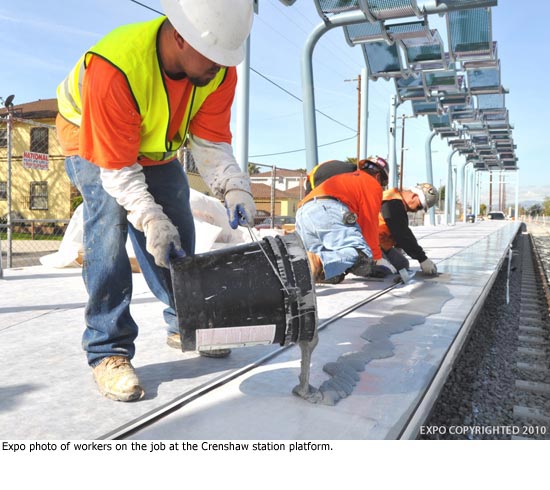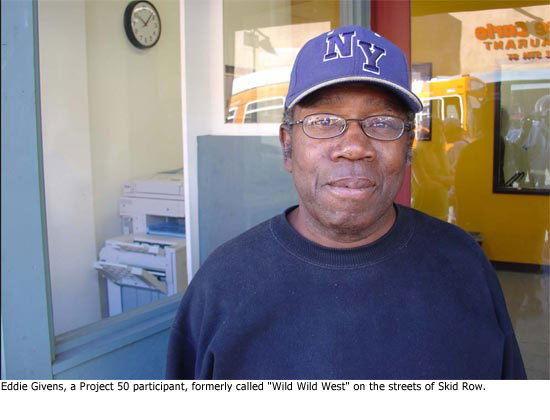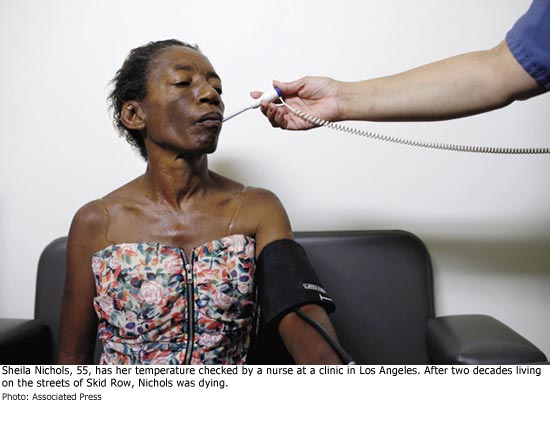Sheriff race bias in Lancaster?
August 6, 2010
 A special counsel to the Board of Supervisors has raised serious concerns about whether blacks in Lancaster are being arrested far too often by sheriff’s deputies for so-called “contempt of cop” violations.
A special counsel to the Board of Supervisors has raised serious concerns about whether blacks in Lancaster are being arrested far too often by sheriff’s deputies for so-called “contempt of cop” violations.
In a report released Friday, Special Counsel Merrick Bobb said he and his investigators “were troubled by a seemingly overzealous use of such charges against blacks in the Lancaster area.” He said arrest patterns in Palmdale and Carson raised some of these same concerns, “but to a lesser degree.”
The findings are contained in Bobb’s 29th semi-annual report on the Los Angeles County Sheriff’s Department. This one focuses largely on potential racial disparities in arrests during 2007 in which suspects were accused solely of crimes against police officers. Broadly called “obstruction,” these include resisting arrest, delaying or obstructing a peace officer and battery on a police officer without injury.
Bobb said that high numbers of these kinds of arrests involving specific racial groups are a warning sign of possible systemic discrimination by police.
Although Bobb said he found “significantly disproportionate” numbers of obstruction arrests by Sheriff’s deputies assigned to the Lancaster station, that was not the case in Los Angeles County overall, despite the fact that blacks are being arrested in numbers that far surpass their representation in the population.
In coming to that conclusion, Bobb compared the proportion of obstruction arrests to the number of total arrests for blacks, Latinos and whites. Among the three, he found the proportions to be roughly similar.
“Our findings do not demonstrate that there is a greater burden on blacks in general in the county [for obstruction],” Bobb said. “Even though the general criminal justice system in Los Angeles falls more heavily on blacks.”
Bobb said there were, however, significant differences among the races in whether those obstruction arrests were filed as felonies or misdemeanors, with Latinos and blacks facing the more severe charges far more often.
Bobb offered no firm explanation for what he called the troubling racial disparities in Lancaster, located 55 miles northeast of Los Angeles. There, blacks, who represent only 17% of the population, comprise 42% of all arrests. They account for 64% of the obstruction arrests—a disparity far larger than anywhere else the Sheriff’s Department patrols in L.A. County.
 In an interview, Bobb said the sheriff’s top commander in the Antelope Valley region, Chief Neal Tyler, told him that residents expect the department’s nearly 200 sworn personnel to police aggressively.
In an interview, Bobb said the sheriff’s top commander in the Antelope Valley region, Chief Neal Tyler, told him that residents expect the department’s nearly 200 sworn personnel to police aggressively.
“He noted that those communities ask for and demand a level of [patrol] activity that may result in more confrontations and stops,” Bobb said, adding that Tyler agreed that the issue “merits further inquiry.”
Sheriff’s spokesman Steve Whitmore said the department was pleased with Bobb’s countywide findings and will examine closely the potential problem areas cited in the report.
“Yes, L.A. County can do better and we will always strive to improve,” Whitmore said, acknowledging that the department polices aggressively in the high desert cities of Lancaster and Palmdale “to keep the streets safe and secure. It’s an aggressive area.”
As part of his latest report, Bobb also examined hate crimes and the department’s investigation of them.
Bobb praised the department’s Hate Crimes Task Force, calling it “a model of its kind.” Between 2007-09, the two-detective unit investigated more than 200 hate incidents and crimes, nearly half of the county’s cases. The unit has been widely praised in the gay and religious communities, Bobb said in an interview.
In contrast, Bobb found that the quality of hate crime investigations conducted at five randomly selected sheriff’s stations “varies considerably, from poor to acceptable to very good at the West Hollywood Station.”
He was harsher when it came to the department’s treatment of hate crimes inside the county’s jails.
“Investigation of hate crimes in the jails is shameful and reflective of an unwillingness or inability to recognize hate crimes as such,” Bobb said in his report.
Among other things, he said that potential hate crimes are not thoroughly investigated.
The report cited a 2009 case in which a disabled white man was beaten for two days by at least three inmates before jailers came to his aid, the report said. He was choked, punched and beaten with one of the inmate’s prosthetic leg.
Bobb said evidence suggested he might have been beaten because he was white, disabled or for both reasons. The assailants allegedly called him a “blue eyed devil” during one of the beatings. A deputy later noted in a report that “I believe the primary motivation for the [assault] was due to [the victim’s] disability.”
Bobb said he found it “shocking” that the investigating detective appears to have “simply abandoned the case…despite known suspects and much testimony on record.” Bobb said investigators seemingly “let the case fall through the cracks.”
For the special counsel’s complete report, including recommendations, click here.
Posted 8/6/10
Same-sex weddings on hold in county [updated]
August 5, 2010
 Same-sex couples hoping to tie the knot in Los Angeles County can’t say “I do” just yet.
Same-sex couples hoping to tie the knot in Los Angeles County can’t say “I do” just yet.
The Los Angeles Registrar-Recorder/County Clerk announced that it will not be performing any same-sex marriages until this week’s U.S. District Court judgment is formally entered.
U.S. District Chief Judge Vaughn R. Walker ruled Wednesday that California’s Proposition 8 barring same-sex marriages was unconstitutional. Proposition 8 proponents have asked Walker to stay his judgment until they can appeal. Parties in the case have until Friday to weigh in on the matter, after which the judge will decide to either formally enter his decision or stay it pending appeal.
County Clerk Dean Logan issued a press release saying that his office is “unable to expand our services to same sex couples until entry of the final judgment. We will continue to monitor any new developments and will take immediate action to implement the Court’s ruling once it becomes effective.”
Updates will be posted on the Registrar-Recorder/County Clerk’s website. Zev’s statement on Walker’s ruling is here.
Posted 8/5/10
Updated 8/12/10
U.S. District Judge Walker on Thursday refused to permanently stay his ruling overturning Proposition 8. But he did agree to give its sponsors until Aug. 18 to appeal his ruling to the U.S. 9th Circuit Court of Appeals, after which time same-sex marriages can again begin to take place.
Dean Logan, Los Angeles County’s Registrar-Recorder/County Clerk, said in a statement that, pursuant to the judge’s ruling, his office would “cease to enforce Proposition 8” after 5 p.m. on August 18 and would start to issue marriage licenses and perform civil marriages.
Logan said his office would extend regular office hours at designated county facilities to handle the expected surge of requests.
The Registrar-Recorder/County Clerk, he said, “will seek to meet customer demand for every qualified couple seeking a marriage license or a civil marriage ceremony at County facilities.”
Information on the extended hours of service will be available at www.lavote.net by Friday, Aug. 13 after 5 p.m. Marriage license information can be accessed online at www.lamarriage.lacounty.gov.
Board seeks input for 2011 redistricting
August 5, 2010
It’s enshrined in the U.S. Constitution and has been carried out every decade since 1790. But the process of redistricting legislative seats every ten years based on the population shifts recorded in each new Census is still invariably messy and contentious.
To help ensure that next year’s redistricting process for the County’s Board of Supervisors is conducted in a timely, orderly and open fashion, Supervisors Gloria Molina and Zev Yaroslavsky have submitted a motion directing county officials to report back within 60 days with information on the past two county redistricting efforts and relevant legal history. The officials will also submit recommended policies and procedures to carry out the current redistricting process for the five supervisorial districts as effectively as possible.
Redistricting has a controversial history in Los Angeles County. In 1988, President Reagan’s Justice Department, joined by other plaintiffs, sued the county, alleging that county supervisors violated federal civil rights laws by deliberately adopting district lines to prevent election of a Latino county supervisor and effectively disenfranchising the county’s sizeable Latino population. The federal courts ultimately agreed, and after exhausting appeals that reached all the way up to the U.S. Supreme Court, the county was finally ordered to redraw district lines that with minor population adjustments remain in place today.
Key to next year’s redistricting process will be a robust public participation plan to create opportunities for members of the public to receive information, attend hearings and offer written or oral testimony about aspects of the redistricting process of particular interest or concern to the county’s numerous and diverse communities.
Posted 8/5/10
Expo may reach La Cienega by next summer
August 4, 2010
It’s full speed ahead for the Expo Line.
A street-level, two-platform station next to Dorsey High School has been approved by the California Public Utilities Commission, setting the stage for an anticipated partial opening of the line as far as La Cienega Boulevard by next summer.
The Farmdale Avenue station to be built by Dorsey High will be an essential part of the light rail line, which will parallel the heavily-congested Santa Monica Freeway and eventually stretch from downtown to Santa Monica, attracting a projected 64,000 riders a day. The project also will include pedestrian paths and a bikeway.
Placing an Expo Line crossing at street level next to Dorsey was opposed by some in the community, who voiced concerns about the safety of students. The CPUC-approved plan to construct a street-level station at the site comes with a number of key safety enhancements, including a 15 mph speed limit for trains passing through the intersection and a requirement that trains come to a full stop to pick up and drop off passengers before proceeding into the area. Other features include gates and LED signs to signal approaching trains.
Constructing a station, rather than the crossing that originally was envisioned, will add $10 million to $15 million to the $862 million cost of the first phase of the Expo Line project. The CPUC’s decision on the matter serves as final approval for a settlement reached earlier this year among the Exposition Construction Authority, the Metropolitan Transportation Authority and the Los Angeles Unified School District.
Phase 1 will end in Culver City. That part of the project is set to be completed by the summer of 2012.
Phase 2, to extend the line to Santa Monica, is gearing up now. The final environmental impact report for the project’s $1.5 billion second phase was approved by the Exposition Metro Line Construction Authority Board in April. (Read the blog that Zev wrote before that vote here.)
Two firms—Skanska-Rados and URS-Shimmick—currently are working on preliminary engineering for Phase 2, and are competing for the design-build contract that the Expo board is expected to award in February, 2011.
LA Observed recently posted a lively YouTube video, complete with rhythmically pulsing soundtrack, of the terrain that the Expo Line eventually is expected to cover from West Los Angeles to Santa Monica. More than 23,000 viewers have already taken the virtual ride.
Posted 8/4/10
Sleeping with the (bed bug) enemy
August 4, 2010
 What used to be a throwaway line before bedtime—sleep tight, don’t let the bed bugs bite—has new significance in Los Angeles County these days. Bed bugs have long been in residence here, but now their presence has reached epidemic proportions, prompting experts to scratch their heads—and others to scratch all over.
What used to be a throwaway line before bedtime—sleep tight, don’t let the bed bugs bite—has new significance in Los Angeles County these days. Bed bugs have long been in residence here, but now their presence has reached epidemic proportions, prompting experts to scratch their heads—and others to scratch all over.
What’s more, public health officials say that across the country there’s evidence that the insects are moving out of the bedroom and into less expected venues, like buses and movie theaters. With all the talk about bed bugs these days—they even figured in a plot line on an episode of “30 Rock”—it’s easy to become alarmed at the prospect of a seemingly unstoppable and ubiquitous pest.
But these dreaded insects are hardly invisible. They can be seen with the naked eye, so knowing the enemy is fairly simple. The Internet is full of bed bug photos; there’s even a site called Pictures of Bed Bugs. And there are a number of basic, common-sense steps you can take to protect yourself. (More about those shortly.)
Still, figuring out the reasons behind bed bugs’ L.A. population explosion is a little more complicated.
“There are a number of theories out there, but no one’s ever going to know for certain why bed bugs suddenly became such a big problem,” says Gail VanGordon, chief environmental health specialist for the Los Angeles County Public Health Department’s Vector Management Program. “When I started at the health department 25 years ago as an entomologist, I saw maybe one or two bed bug cases a year. And for some reason in the early ‘90s the number started creeping up to the point where they are really an epidemic now. One of the theories is an increase linked to global travel.”
Other possible factors are an increased bed bug resistance to pesticides or—at the other end of the spectrum—less pesticide use by environmentally conscious consumers. “We’ve learned to distrust pesticides,” says Alec Gerry, an entomologist at UC-Riverside. “In the old days, we trusted the heck out of them and used them all over the place and we didn’t worry about the consequences to the environment or to ourselves.”
The good news is that humans are still smarter than bed bugs; the bad news is that bed bugs are very good at what they do. With no need for thumbs to catch a ride, bed bugs expertly hitchhike from place to place by crawling into clothing, backpacks, suitcases or any other item that rests on the floor in close proximity to humans.
Sometimes people panic and misinterpret a simple insect bite as evidence of bed bugs.
But knowledge is power. By learning the facts, your chances of hosting an infestation are greatly reduced. Here are some tips:
Be careful what you bring into the house. “If they are going to buy furniture or trade furniture, don’t bring anything in where bed bugs can hide. They should check it very closely,” VanGordon says. “We don’t recommend buying used furniture at this time because so much of it is infested.”
Cleanliness is your best weapon. “Sanitation is topmost. People would think it’s pesticides, but it’s not. It’s just very good housekeeping,” VanGordon says. Bed bugs are easily vacuumed up with a strong hand tool and consistently washing bedding is an effective strategy for prevention. Still, people in apartment buildings should practice extra caution when using shared laundry rooms. VanGordon recommends buying washable laundry bags to reduce the possibility of bed bugs crawling into hampers or baskets placed on the floor.
Don’t let your guard down when you’re on vacation. Hotel and motel rooms are bed bug hot spots. Travelers should take extra precautions no matter where they are staying. VanGordon has a routine she uses when staying at a hotel.
“We put our luggage in the middle of the room and lift the head board off of the wall and look behind the head board and look underneath, looking for the signs of bed bugs,” said VanGordon. “Then, even when we feel comfortable, a lot of times we won’t even take our clothing out and put it in the furniture provided in the room. A lot of us just pull it out of the suitcase and we keep it on the rack and check very carefully for signs of bed bugs.”
Keep a close watch on your bed—or wherever you fall asleep. Bed bugs earned their name for a reason. With nocturnal habits, they lurk close to a predictable nighttime blood supply, most often a bed, but sometimes a sofa or chair if that’s where you doze off. And then they start feasting.
“Eighty-five percent of populations are located within 15 feet of the center of the bed,” VanGordon says. So if you think you have an infestation, start there. Systematically search all surfaces on and near the bed, and vacuum or wipe up the bed bugs and clean off any remains they’ve left behind. And consider removing as much clutter as possible from your bedroom because clutter is just one more place for bed bugs to hide.
“Prevention is always better than addressing an established bed bug infestation. Know the signs and address it immediately,” VanGordon says.
More public health tips—including guidance on what to do if preventive measures fail and the bed bugs do move in—can be found here.
Posted 8/4/10
More scrutiny for public paychecks
August 3, 2010
 Continuing revelations about salary and pension abuses in the city of Bell have stoked popular outrage and served as a wake-up call for elected officials up and down the state.
Continuing revelations about salary and pension abuses in the city of Bell have stoked popular outrage and served as a wake-up call for elected officials up and down the state.
But while Bell officials have largely stonewalled the press and public in releasing key information, the county of Los Angeles has long posted elected officials’ salary and tenure information, as well as a payroll list of all County employee job classifications and salary ranges. However, with department head compensation listed only by salary schedule code—not by name—the public can’t readily determine exactly what they’re paying those top executives.
To shed some light on the issue, Supervisor Zev Yaroslavsky has authored a motion to be placed on the Board of Supervisors’ agenda for August 10. The motion would require that within two weeks the county’s Chief Executive Officer and Auditor-Controller compile, post online and regularly update detailed salary information for all county department heads by name, similar to the posting for the county elected officials.
Meantime, State Controller John Chiang has announced that he will begin collecting and posting detailed local government salary information for the state’s 58 counties and 480 incorporated municipalities.
Posted 8/3/10
Not because it’s easy
August 3, 2010
Philosophical arguments for—and against—an innovative initiative to combat homelessness surfaced Tuesday as Project 50’s most passionate proponent on the Board of Supervisors exchanged views with its leading skeptic.
Their comments came in response to the Los Angeles Times’ four-part series on Project 50, which began in late 2007 and has provided housing to those deemed likeliest to die on Skid Row. It has done so without requiring participants to agree in advance to treatment for substance abuse and other problems, although clients are continually pressured to avail themselves of a range of medical, psychological and drug treatment services once they enter the program. So far, 100% of those who have been housed have received at least one of those services.
Tuesday’s debate turned on the question of housing people without first requiring that they give up drugs.
Supervisor Michael D. Antonovich, a longtime critic of Project 50, spoke first, followed by Supervisor Zev Yaroslavsky, the program’s sponsor and most vocal supporter on the board.
Here is a summary of what each supervisor had to say:
Antonovich started by reading from the newspaper’s first installment, which offered a range of anecdotes about the program’s successes and failures, and ended with an account of the difficulties one long-time drug user was experiencing. It centered on a woman who was beset with “psychological triggers everywhere,” including the smell of crack cocaine vapors as she tried to resist temptation. At one point, she tried to turn her money over to a program official so she would be unable to purchase the drugs that were tempting her. But the official explained she could not legally take her money, and instead helplessly watched as the woman went in search of drugs. “Was it possible to keep people under a roof, even if their addictions and mental illness remained untreated?” Antonovich read, quoting from the article.
Antonovich then reprised some of the questions he had asked when Project 50 came before the board in 2008. He said that assurances he had received then were being proven wrong by the latest quarterly report from Project 50, which he said indicated that “two years into the demonstration, half of the residents with a history of substance abuse are not being treated, which is warehousing without healing.”
He asked Chief Executive Officer William T Fujioka to report back in 14 days on “prohibitions currently in place against Project 50 residents continuing to abuse substances while being housed at taxpayers’ expense.”
Then it was Supervisor Yaroslavsky’s turn.
“I think everyone within the sound of my voice should understand a few things about this program,” Yaroslavsky said. “No. 1, nobody was required as a prerequisite of entering the program [to submit] to a substance abuse test or treatment or see a shrink or do any of the other things as a precondition of entering the program. This is what is revolutionary about this program…If you take the 50 most vulnerable…people on Skid Row or anywhere else in the county and say, ‘Hey, we’ve got a unit for you but we want you to go see a psychiatrist first,’ he’ll tell you to take a walk. That’s been the experience.”
Yaroslavsky noted that the participants “were the 62 most chronically homeless people on the streets of downtown Los Angeles at the time they were selected.” He added that “100% of the people who were part of this program got [at least one kind of] treatment—100%. If we had not done this program, none of them would have gotten treatment. They would still be living on the street. And many of them would be dead.”
He said he was reminded of “President Kennedy’s comment when he launched the project to the moon, where he said, ‘We choose to go to the moon not because it is easy but because it is hard.’ This county chose to do Project 50 not because it was easy but because it was hard.”
He concluded by praising Fujioka and others involved in getting Project 50 launched for “having the courage to risk failure.”
“That’s what we don’t do enough of in the public sector…When you try something different, you risk failure. And nobody wants to be associated with a failure. This is not a failure. This is a success—a risk worth taking.”
To date, 84% of the Project 50 participants are still being housed.
Read Zev’s blog on Project 50 here.
Why Project 50 saves lives
August 2, 2010
If you want to solve homelessness in Los Angeles, you have to start on Skid Row.
I heard that observation voiced by a participant at a conference I convened in 2007. The words rang true to me then, as they do now. It is a simple declaration of a difficult fact: that Job One in fixing the national disgrace at the heart of downtown means trying some innovative tactics to begin alleviating some of the miseries endured by individuals on the street there.
The Los Angeles Times is now in the midst of a four-part series chronicling Project 50, the initiative that grew out of that conference. As the first story points out—and as the newspaper suggests in promoting the upcoming installments—it has been a difficult journey, with many hard-won successes and some disappointments along the way.
Project 50 is one of the most rewarding public policy initiatives I have ever sponsored. Its foundations were established at that 2007 conference, sponsored by the Rockefeller Foundation. We brought people to Los Angeles from across the country—people who had successfully turned around homelessness in their own cities and counties. Before meeting with our policy makers and civil servants, these out-of-town participants toured Skid Row, and every one came away recommending that we start there.
Roseanne Haggerty, who runs Common Ground, a New York non-profit that deals with homelessness, suggested we launch a pilot that would identify the most vulnerable homeless people on Skid Row—those most likely to die on our streets. Then, we’d find them a place to live and give them the services they needed. In the language of homeless advocates, this is called permanent supportive housing.
Since we would be going after the most troubled people—the hardest cases who for years had resisted every program to come along—we needed to be innovative to reach them. So we broke with conventional practice and did not make it a precondition that participants accept services in order to get a roof over their heads.
But once we got them housed, our county and affiliated non-profit agencies had one, unified goal: to surround them with the health care, mental health care and substance abuse services they required.
It was a relentless mission. Once these clients moved in, our people were on them like a wet blanket, pushing to get them the help they needed.
And here’s the striking part: every single participant ended up agreeing to accept at least one kind of treatment.
What has evolved in the last 2 ½ years has been nothing short of remarkable. Project 50 has actually housed 68 homeless persons, most of whom had health, mental health and substance abuse issues. Many had been homeless on the streets of Los Angeles for more than 10 years; one had been homeless for 37 years. These were the most challenging of the challenged homeless persons in our county. And because of Project 50, we were finally able to break through—not to all, but to a very substantial majority.
Since 2008, nearly 84% of those we housed remain housed, a statistic which has left in tatters the myth that we can’t get chronically homeless persons into housing. And 100% of the clients have received one or more of the health care, mental health or substance abuse treatments they desperately needed.
A collateral benefit is that this pilot has been a money saver as well—a point recognized by the Economic Roundtable and others. The cost of running this program is more than made up by the savings realized by the relative stability that has been restored to our clients. Before Project 50, most of its participants landed in jail or in hospital emergency rooms multiple times each year. Since being in the program, most have avoided incarceration or hospitalization at a considerable financial savings to taxpayers.
And when progress is measured in human lives saved—lives that almost certainly would have been lost on the streets without Project 50—that represents a success well worth celebrating and replicating.
Project 50 has rapidly expanded beyond Skid Row to other parts of the county. Nearly 400 permanent supportive housing units are in the pipeline in West L.A., Van Nuys, Venice, Santa Monica, Hollywood, West Hollywood and Long Beach. Other communities have expressed serious interest as well.
Los Angeles has often been called the homeless capital of the nation, and one could hardly argue with that moniker. It can be very daunting to try to address the housing and service needs of well over 10,000 chronically homeless people in our county. That’s why dealing with them 50 or 500 individuals at a time made so much sense to me. Project 50 established the template. The same methodology that was applied to housing 50 chronically homeless can be applied to 500 or 5,000.
Thanks to this project, and its courageous and dedicated county employees and their non-profit partners, we are on our way.
Posted 8/02/10
L.A. Times columnist Steve Lopez has weighed in on Project 50, praising its hard-won successes for the chronically homeless on Skid Row as “no small triumph.” Read his column here. And our article on the Project 50 debate that cropped up at last week’s Board of Supervisors meeting is here.













 Check for the latest closure information
Check for the latest closure information








